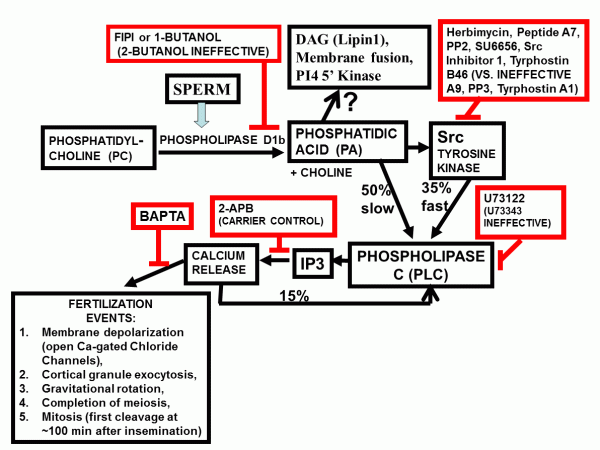 Dr. Stith and his lab found that insulin or progesterone addition to Xenopus oocytes increased tyrosine kinase activity and phospholipase C activity (phospholipase C produces IP3 which releases intracellular calcium, DAG which activates protein kinase C). First to successfully use an IP3 mass assay with Xenopus cells (two years in development), he provided the first report that fertilization involved an increase in the mass of IP3 (1993). He found another event in Xenopus fertilization: elevated calcium stimulated IP3 breakdown (use of intracellular calcium buffers resulted in a large increase in IP3 mass during fertilization). His lab also used these calcium buffers to prevent fertilization events but found that phospholipase C activity still increased; this suggests that sperm do not elevate calcium to stimulate phospholipase C. The time course of phospholipase C activation found that the activity was high during the slow calcium wave (3 min to travel the egg from the sperm binding site)...this time course, and the measurement of IP3 mass, supports the idea that the calcium wave is due to a wave of elevated phospholipase C/IP3 production. As the lipid phosphatidic acid is also produced over this time, this lipid may also play a role in the calcium wave.
Dr. Stith and his lab found that insulin or progesterone addition to Xenopus oocytes increased tyrosine kinase activity and phospholipase C activity (phospholipase C produces IP3 which releases intracellular calcium, DAG which activates protein kinase C). First to successfully use an IP3 mass assay with Xenopus cells (two years in development), he provided the first report that fertilization involved an increase in the mass of IP3 (1993). He found another event in Xenopus fertilization: elevated calcium stimulated IP3 breakdown (use of intracellular calcium buffers resulted in a large increase in IP3 mass during fertilization). His lab also used these calcium buffers to prevent fertilization events but found that phospholipase C activity still increased; this suggests that sperm do not elevate calcium to stimulate phospholipase C. The time course of phospholipase C activation found that the activity was high during the slow calcium wave (3 min to travel the egg from the sperm binding site)...this time course, and the measurement of IP3 mass, supports the idea that the calcium wave is due to a wave of elevated phospholipase C/IP3 production. As the lipid phosphatidic acid is also produced over this time, this lipid may also play a role in the calcium wave.
In 1997-1998, we also recorded the increase in DAG mass and activation of protein kinase C during Xenopus fertilization. We noted that 99% of the large DAG increase was not from phospholipase C action, but suggested that phospholipase D (PLD) was responsible. PLD breaks down phosphatidylcholine to produce phosphatidic acid (PA) and choline. While we showed choline mass increase, we also developed new HPLC methodology (with evaporative light scattering mass detection; ELSD) with Avanti Polar Lipids and showed that fertilization was associated with an increase in PA. PA was found to bind to Src tyrosine kinase (with higher affinity than 14 other signaling lipids) and induce a cycling of Src activity, along with PLCgamma tyrosine phosphorylation, IP3 production and calcium release. That is, PA fully mimicked sperm activation of eggs and induced fertilization events.
